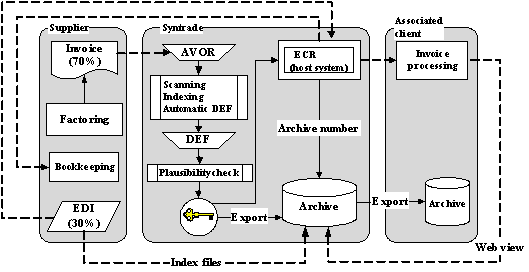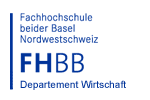Electronic invoice processing at Syntrade AG
Syntrade AG is a clearing house for 32 clients who use its factoring services in the retail trade. It processes the payment of suppliers’ invoices for its customers. Up to now these documents were recorded manually and archived on microfilm. With the renewal of the ERP system, Syntrade automated the invoice processing system and introduced a central, electronic archive. By using a digital signature, the scanned documents can be stored there in a legally valid way on variable data carriers. The process is recognised by the Swiss Tax Authority and conforms to the guidelines for storing electronic documents.
Inhaltsverzeichnis
1. The company2. E-Business strategy
E-Business vision, supply chain management, choice of partner, multi-tier process
3. Integration solution
Hybrid integration, internal integration, external integration, core process, payment regulation, regulation process, system architecture
4. Implementation
Set of rules, digital signature
5. Operation
Costs, process costs, profitability
6. Success factors
VAT-compliant electronic archiving, central archive, detailed concept
1. The company
Origin:
Coop Switzerland centralised the payment system of individual regional businesses in 1985 and was thus able to secure a discount of 1.5% from its suppliers. The rest of the trade was now at a disadvantage compared to the Coop and looked for possibilities to achieve similar reductions. Thus, five years later the the purchasing company 3. Kraft came into being as a central payment office of the Denner Group and the then Hofer & Curti Group with the involvement of Metro. A system was operated dealing purely with payment transactions, where the integrated companies transferred payment to the purchasing company 3. Kraft after the invoice had been checked. Under the management of EPA AG, Valora AG and Volg Konsumwaren AG, eleven medium-sized companies formed an independent company in 1993 – Syntrade Service AG. This was organised along the lines of the German central regulator and operated a collection system. After termination of the cooperation within the framework of the purchasing company 3. Kraft, the Hofer & Curti Group formed its own payment company MABEAG in 1997. The merger of Syntrade Service AG with MABE AG to form Syntrade AG in 1998 turned the group into a company of a similar size as, e.g., Migros in the purchasing sector.
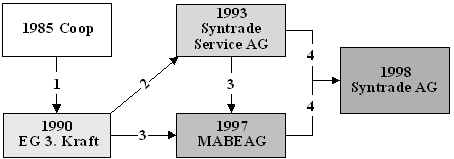
Fig. 1.1: Origin of Syntrade AG
Business segments:
Syntrade is a service company for SMEs in Swiss commerce. The company develops additional value-added sources for its customers, shareholders and associated clients by bundling services. Associated clients are direct or indirect shareholders in Syntrade. Together they represent approx. 20% of the total Swiss retail trade.
Syntrade operates in three business segments:
1. Central regulation
The suppliers of the associated clients conclude basic agreements with Syntrade. They benefit from the optimisation of the payment transactions, the del credere cover and the coordinated market processing between industry and trade.
2. Service
Within the framework of the core process “payment regulation“, the main focus is on the processing and handling of data. The following services are furnished:
- Data acquisition, processing, transmission and conversion
- Legally valid digital archiving
- Payment regulation and invoice inspection
3. Profit Centre Pooling
Reduction in costs for working capital by bundling the procurement for shareholders, associated clients and customers.
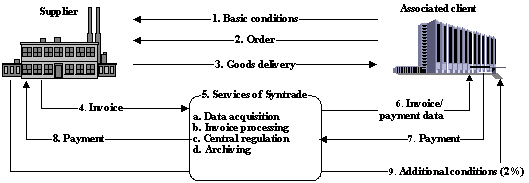
Fig. 1.2: Syntrade as an outsourcing partner
Syntrade operates in the value-added chain between suppliers (industry) and their associated clients (trade). The suppliers secure their sales in 20% of the overall market and are included in covering marketing measures. They no longer require any reserves for del credere, since Syntrade guarantees payment together with a credit insurer. The associated clients receive 2% discount on the purchasing volume processed via Syntrade.
Syntrade supplies the documentation for payments and the corresponding electronic data for the automatic entry in the connected suppliers’ or customers’ systems. This allows the associated clients to largely automate the inspection of invoices and the payment process. Per year, Syntrade processes with its 35 employees 1.3 million invoices and processes payment to the sum of CHF 3.78 billion for 32 associated clients requiring factoring services, such as, e.g., Manor AG.
Market position:
Syntrade offers its services in Switzerland and in the principality of Liechtenstein. In the field of electronic invoice processing, Syntrade plays a leading role. Competitors in the field of central regulation do not exist on the Swiss market at the present. Syntrade develops programs and processes, so that invoices can be used both for the purposes of VAT and in relation to regulations governing regularity and storage exclusively in an electronic data format without paper and additional documents.
2. E-Business strategy
Importance of E-Business in corporate strategy:
Starting position
The system for central regulation which Syntrade had used previously was no longer supported by the provider. In this system, the supplier invoices were recorded manually and archived on microfilm. This required high labour input and had a high error rate. The whole process was time- and cost-intensive. The new system which is now in use opened up rationalisation potential through new functions. Thus, the data transfer can, for example, be largely processed between the suppliers and Syntrade in an electronic form for both received and transmitted data. It is based on the newly introduced European Central Regulation (ECR), which carries out the processing of invoice data as the ERP system, and on the hybrid receiving systems EDI for electronically received documents and ISLAND for documents on paper. The system was introduced within the framework of the MORE project (modern regulation). A crucial sub-project was ISLAND (integrated character recognition with long-term archiving and document management), which is described below.
Syntrade pursued the following goals with this project:
- Development of a “data acquisition and archiving“ competence centre for associated clients and other customers.
- Reduction in the time spent recording data manually and high data quality.
- Legally valid, electronic archiving of documents and fast, selective and highly available access to customer data.
The E-Business vision of Syntrade becomes clear from its objectives:
partners by totally electronic means. It has set itself the goal of increasing the percentage
of electronic invoices to 80% over the next three years and to process all invoices
and other paper-based documents electronically in the long term.
E-Business fields of application in the company:
The Syntrade solution can be allocated to supply chain management segment. The company transfers the processing of paper-based invoices into an electronic process after the invoices have been received. By integrating various applications, individual working processes, e.g. the manual input of invoice data, could be supported automatically or electronically. After processing, the associated clients can view their data in a central digital archive.
Project participants:
Consultancy and implementation company
Interact Consulting AG was founded in 1991 in Switzerland and is a product-independent IT consultancy and implementation company. It specialises in the development and implementation of solutions for processing unstructured information. In the ISLAND project, Interact contributed its know-how in the areas of document imaging and document management.
System provider
Markant GmbH in Germany offers European Central Regulation (ECR). Over 100 trading companies in various European countries participate in the central regulation system. Thus, 294,000 documents are processed by 4,660 industrial companies each week amongst Markant’s partners.
Choice of partner:
Syntrade used a multi-tier system to select its IT partner. The specification was sent to seven providers with an offer enquiry. The concepts which Syntrade received had too little substance. In a subsequent provider evaluation the additional benefit of “free document processing” was recognised. Interact won the Syntrade contract due to its expertise in the field of scanning and electronic archiving. The recommended solution stands out due to its consistent use of leading and tested standard products and through high scalability. Interact also proved that it had an excellent understanding of the problem.
3. Integration solution
The Syntrade solution is a hybrid integration. The internal integration of the software modules for electronic invoice processing is a key part of the process examined below. External integration is achieved by means of the web access of the associated clients to their invoice data.
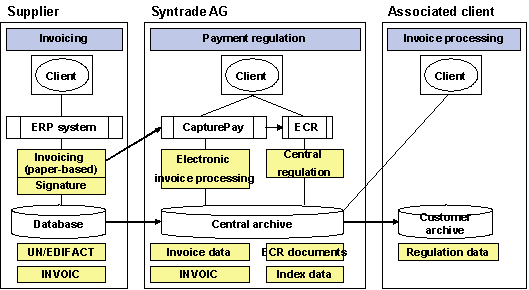
Fig. 3.1: Hybrid integration
Business perspective:
Syntrade accepts suppliers’ invoices as an interaction partner, processes them in its system and then carries out central regulation. The ISLAND project was launched in April 2000 in cooperation with Interact.
The exchange of data with the new ECR system was to be optimised for both received and transmitted data by processing documents electronically respectively through a central digital archive. In this way, it was possible to automate the recording and processing system to a large extent. After the invoices have been processed the data is stored in a central, digital archive. Data quality could be increased by means of the electronically supported processing system.

Fig. 3.2: Manual vs. Automatic recording of documents
The labour input for processing invoices was be reduced from the previous 20 persons to 13 persons. The company aims to utilise the resources which have become available to increase the volume of processed data within the company.
Process view:
The core process payment regulation is dealt with by Syntrade as follows: the suppliers send the invoices addressed to the associated clients to Syntrade. In doing so, around 70% of documents are submitted in paper form and 30% electronically via Electronic Data Interchange (EDI), according to the UN/EDIFACT standard. In the work preparation phase (AVOR), the paper documents are prepared for scanning. This is carried out in batches and produces picture data in TIFF format. The acquired picture data is checked visually and optimised prior to the data recording process, so that they become legible for character recognition (OCR). Here, the document data is read out automatically. Data which is recognised as unsafe has to be checked manually.
After the invoice issuer has been determined an employee checks whether the page breaks between the documents has been carried out correctly. They also make sure that the recognition system (set of rules) to be used for the document and the document type have been recognised correctly. The picture data is now automatically read out according to the stipulated set of rules in the data recording system (DEF). Individual fields of the document which have not been safely recognised are supplemented in the manual data processing phase. The acquired document data is subjected to an automatic plausibility test. Here the document is checked to see whether the net amount plus VAT corresponds to the gross amount. The previous single-page TIFF are compiled in their logical unit, i.e. the first page of the document and the following pages are merged into a multi-page TIFF.
Regulation process:
Fig. 3.4: Regulation process
The electronic pictures are signed in the PKI module with the private key of Syntrade and exported to the central Syntrade archive. The invoice data is then transferred to the ECR system. If the data of the document is accepted by the ECR system, this issues a clear archive number. This is archived with the document. After regulation has been carried out, the data is periodically sent to the invoice processing department of the associated client. The latter can view its data in the central archive via a web interface (web view). The invoice is paid by the ECR and can be recorded in the supplier’s bookkeeping system. On request the data can be exported into the associated client’s archive.
Application view:
In the case of the integrated Syntrade solution, data is generated within the system and used by Syntrade both by means of an OnDemand client and by customers via web access or archive export. The integration is based on two levels in the case of the hybrid solution. Internal integration takes place at the application level. The business process is matched to the application logic and can therefore be carried out more efficently. External integration is achieved at data level. In the following chapter, the integration of the individual components and their functions are described in detail.
System architecture:
The system consists of various sections. The documents are first recorded by a standard Kodak scanner. The CapturePay product from Interact is based on an XML framework and integrates software for document recording, indexing, document analysis, data extraction, manual correction and for digital signature. This part of the system controls the whole document recording and signature workflow. It is run on Windows 2000 on an IBM xSeries eServer .
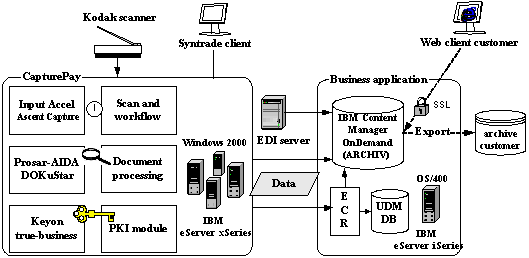
Fig. 3.5: system architecture
The acquired data is forwarded by file export to the business application. The ECR system and the archive load the data via batch process from a transfer directory.
Electronic documents (EDI) can be submitted with the corresponding paper invoice. In this case, the scanned paper invoice is matched up with the invoice. The relevant data is extracted and exported to the ECR system and processed there. A Windows PC is used in this case as an EDI server.
The European Central Regulation (ECR) is a host system. This includes processing programs for central regulation (ECR batch) and enquiry programs for informing suppliers and customers (ECR dialogue). In the ECR system, the documents are checked and verifed for plausibility in two steps. Defective documents are rejected and have to be reprocessed. Correct documents are converted into the leading currency (CHF as a rule) and transferred to a basic file. The documents are then assigned an archive number. These can therefore already be called up in the archive prior to the actual regulation. The electronic archive is based on IBM’s OnDemand content manager. Customers have the possibility to access their data directly via the Internet (web client). If a shorter access time is required, access is possible via a virtual private network by means of the OnDemand Client. There is also a possibility of exporting the data into the customer’s own archive or onto CD-ROM. Individual documents can also be sent by e-mail. The corporate data model (CDM) is a database that stores master data of suppliers and customers. This data supplements the data gained from processing the document and is additionally stored in the archive as index information. The business application is run on OS/400 on an IBM eServer iSeries.
4. Implementation
Project management:
The ISLAND project was a sub-project of the overall MORE project. Syntrade coordinated the individual projects. Interact implemented the scanning, imaging and electronic archive within the ISLAND project. The main task of Interact was to integrate the software modules and to adapt them to the specific needs of Syntrade.
Software solution:
The software solution stands out especially due to the flexible set of rules for automatic document recognition and the use of a digital signature.
“Set of rules“
With the new system each paper document is scanned after it has been received by post. Subsequent processing is carried out electronically. The documents are structured differently depending on the supplier, i.e. the relevant information is located on different pages and field contents are not identical. In addition, data may also not be available on the invoice. There is also a danger that mistakes may occur if the invoice is incorrectly addressed or the address is incomplete. The system can only recognise the data based on flexible rules. It has to know, for example, that the VAT can be written as a percentage and the amount can be written in francs or euros in the top right corner or underneath the term “VAT” or “value added tax. Interact developed a set of rules together with Syntrade for automatic document recognition. The implicitly available knowledge for processing documents was transferred to an electronic system and made explicitly available. Interact summarised similar documents into groups. An individual set of rules was specified for each group. While an invoice is being processed, the set of rules simulates human decision-making proceses, i.e. context-based reading of information is possible. Models stipulate which fields of an invoice have to be recorded or extracted.
Digital signature
The recognised certificates of TrustCenter AG from Hamburg, which are recognised by the Swiss Tax Authority (STA) according to Article 12, Section 2 EIDI-V dated 15th October 2002, are utilised. The certificate is stored on a SmartCard and is obtained from the issuing office EAN (Switzerland) together with the card reader. Prior to archiving the digital signature is affixed to the pictures so they cannot be amended. This guarantees document integrity. The advantage of this system is that the data can also be stored on rewritable data carriers (e.g. hard disk) without causing a security risk. The digital signature is necessary for the long-term archiving of VAT-compliant invoices.
5. Operation
Maintenance:
The system’s hardware and software is maintained by Interact and IBM. The rest of the infrastructure, such as the network and databases are maintained by Syntrade’s IT department. It has also taken responsibility for the set of rules and further developed it.
Costs and benefits:
Costs
Syntrade spent approximately CHF 1.5 million on the design and implementation of the system. Syntrade incurred additional costs totalling 20% of the overall investment sum in order to improve the system’s performance. The running costs of the solution come to around 14% of the total investment sum without staff expenses.
Benefits
The savings in terms of process costs are approximately 40% compared to the previous system. They are achieved by reducting the labour input. The error rate for recording data could be reduced by 80%. The time required for the pure recording of an invoice could be reduced by more than 50% of the previous average of 20 seconds to 9 seconds. The throughput time for processing documents was reduced form the previous average of 4.5 days to 1 day. The archiving of paper documents by the associated client is no longeer necessary. Invoices can now be found in the digital archive within seconds. The customers can view, print out and store processed invoices themselves. The invoices are displayed by means of a standard browser in TIFF format. Using digital signatures, the documents can be stored on varying data carriers instead of on expensive optical storage media.
Profitability:
After an initial inspection of the system it transpired that savings of approximately 60% had been achieved compared to the previous system, of which 40% are attributable to staff savings. This result only applies to the internal area of Syntrade. This does not take into account cost benefits due to automated data processing and central digital archiving on the customer side. The investment in electronic document processing was higher than orginally planned. The profitability of the system is to be improved even further in future by means of an extended application range, such as, e.g., the use of central regulation for other associated groups or the processing of delivery notes, forms or applications.
6. Success factors
Specialities of the solution:
With its solution, Syntrade has the first electronic archive on changeable data carriers which has been accepted by the Swiss Tax Authority for VAT-compliant electronic archiving. The automatic recognition and checking of invoices based on stored invoice profiles (set of rules) is also an innovation. The system is constructed in a modular way and can be adjusted to specific needs. It is also possible to process forms, for example, instead of invoices.
Changes:
The time-consuming process of recording documents manually and the subsequent archiving procedure on microfilm could be replaced by an efficient, electronically-supported workflow. With the new system, an average of 8,000 paper invoices from over 600 suppliers are now processed per day.
Challenges
At the beginning of the project, a transfer of know-how took place between Syntrade and Interact in the field of document processing. In order to be able to implement the ISLAND project, Interact had to learn how the documents are analysed and how this information has to be interpreted. Criteria for structuring the set of rules and meaningful search terms within the set of rules could be derived from this knowledge. The system had to be designed so that employees could draw up new sets of rules for new suppliers independently. Designing a total of twelve interfaces also posed a challenge. The involved partners had to coordinate the interface design amongst each other. New interfaces create the connection to the corporate data model, EDI applications, ECR and other systems. Three interfaces are located within the document processing system.
Advantages
The system has achieved a high level of acceptance due to the increased user friendliness and speed as well as an improved user interface. The traditionally text-oriented screen workstations of the IBM eServer iSeries are replaced by graphic user interfaces with pictures and facilitate an ergonomic work method.
Customers now have a central archive at their disposal with external, password-protected web access. This led to considerable reductions in search times compared to the microfilm archive used previously. The time spent researching documents was therefore partly outsourced to customers. The electronic archive is also client-friendly and supports an electronic internal, external and VAT-compliant audit. By using the digital signature, documents can be freeely transmitted to partners and nevertheless still fulfil the function of originals. Syntrade can destroy all paper documents after electronic archiving has been completed.
Lessons learned:
In May 2003, the ISLAND system was accepted by Syntrade. Syntrade was in charge of the project for the whole duration of the project. With hindsight, external project management by a specialist would have been advantageous, due to the high level of specialised IT know-how required.
The costs of implementing the whole project were underestimated. This resulted in a time delay and higher costs. This could have been avoided through close coordination between the involved partners. The additional expense was borne by both Syntrade and Interact.
As the recognition performance for invoice documnts could not be estimated, the creation of a detailed concept beforehand was dispensed with. A prototype was directly drawn up instead. With hindsight, an iterative project approach that envisages a rough and detailed concept and their acceptance would be preferred. The technical implementation of the project was hampered by the basic legal conditions. A large amount of legal uncertainty prevailed with respect to the use of electronic archives. Syntrade and Interact were in close contact with the legislator during the project.
Conclusion
The cost savings due to electronically processed documents are counterbalanced by additional costs in the organisational and legal environment in addition to investments in a new IT infrastructure. Intelligent document processing requires more than scaning and the subsequent text recognition. There are no universal products and the documents and the business processes are the determining factors for any solution. The technology is available and opens up interesting fields of application.

